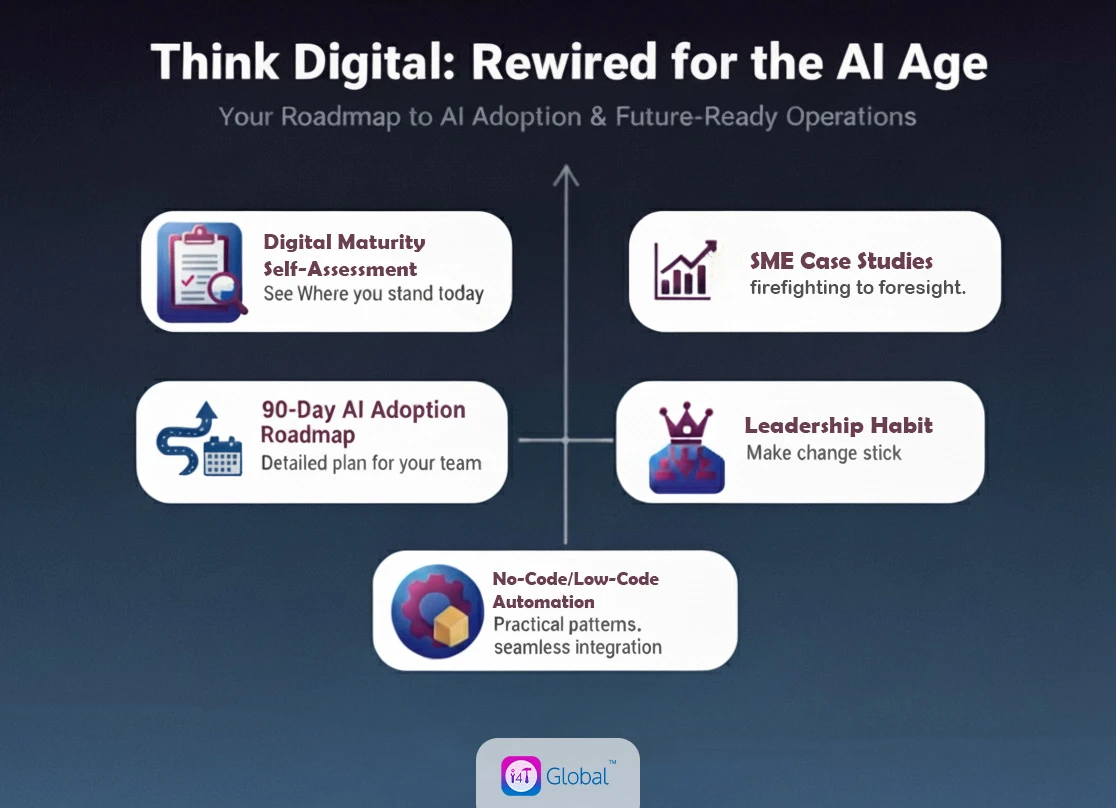On a wet Tuesday in Melbourne, Maya unlocks the office before sunrise. She’s the senior property manager in a small but busy agency, and the storm that barrelled across the city overnight has left its calling card everywhere: roof leaks in Brunswick, a smashed skylight in St Kilda, a dead hot-water unit in Carlton where the tenant has a newborn. Her inbox is a wall of red flags. Tradies are already texting. An owner wants “hourly updates”. Compliance jobs that were neat and orderly yesterday now look like a game of pick-up sticks.
By 9:40 am she’s had two coffees and no breakfast. Someone asks for a status update on “everything”. She laughs, the kind of laugh that’s not far from a sigh.
If you’ve ever sat where Maya sits, you know this day. It’s the day you promise yourself: there has to be a smarter way.
There is. And it’s not science fiction, nor does it demand a seven-figure budget or a squad of data scientists. What it needs is a clear, no-nonsense plan to fold AI into the way you already work, safely, sensibly, and one small win at a time. Think of AI not as a robot overlord but as a tireless assistant that reads the messy emails, drafts the clean work orders, nudges the right people at the right moment, and helps you see around corners before something fails.
This article gives you that plan. It’s a practical 90-day roadmap built for Aussie property managers who want less chaos, faster turnaround, happier tenants and owners, and airtight compliance, without blowing up their current systems. We’ll walk it the way Maya did: month by month, week by week, moving from “this is a mess” to “we’ve got this”.
And at the end, if you want a deeper playbook that turns this journey into a repeatable, team-wide capability, I’ll point you to the new edition of my book, Think Digital: Rewired for the AI Age.
For now, let’s get Maya out of the storm.
Month 1: Audit & Awareness - Finding the Friction, Choosing the First Wins
Maya’s first instinct is the same as yours: fix everything. But she resists. Instead, she grabs two colleagues, from ops and accounts, and throws an hour on the calendar. They sit with a whiteboard and a box of textas.
The rule is simple: draw how a maintenance job really flows in their world, not how the software brochure says it should.
Requests arrive by phone, portal, email, and (because life is rich) Instagram DMs. Someone reads them, decides the priority, creates a job, and hunts for a tradie who’s available, qualified, and in range. Photos dribble in after the fact. Tenants send “just checking in” emails that breed like rabbits. Owners want receipts, proof, and sometimes reassurance. Compliance documents live in five different places depending on who created them.
They mark the sticking points with red dots:
- Messy intake. Re-typing tenant descriptions into work orders is slow and error-prone. “The hot thing is broken” means hot water, the oven, or the temper of a tenant at their wits’ end.
- Inconsistent priority. What’s urgent to one coordinator is routine to another.
- Scheduling roulette. Assignments depend on who answers a call first, not who’s actually the best fit.
- Communication gaps. Status updates are ad hoc. Tenants feel ignored. Owners feel in the dark.
- Compliance catch-up. Photos and certificates arrive late, get misfiled, or sit in an inbox labelled “to sort”.
Now they flip the whiteboard and write two questions:
- Where does AI help immediately without changing everything?
- What can we prove in 30 days that makes everyone breathe easier?
They pick two “tiny bets”:
- The Intake Assistant. A simple AI step that reads the raw tenant message, pulls out the essentials (property, asset, likely category, access notes), assigns a sensible priority based on examples, and drafts a work order for human approval.
- Smart Scheduling Lite. A guided suggestion, not an auto-assign, that lists the top three tradies for each job based on skills, location, licence, and recent performance, with a one-line reason. The coordinator still decides; AI just does the legwork.
Before they touch a button, they check their data. Not a big audit, just enough to know they can feed the assistant something it understands:
- A tidy list of properties and common job types.
- A basic skills/coverage list for their tradies.
- A handful of “golden examples” of good work orders and good updates.
Crucially, they bring the team along. Maya sets up a Friday ritual, “Friday 15s”, where someone shares a small improvement: a prompt that turned a dog’s breakfast email into a clean work order; a template that made an owner update sound human and clear. No jargon. No pressure. Just one per cent better each week.
By Day 30, nothing “fancy” has happened. Yet a quiet shift is underway. The team understands where the pain lives and has agreed on two small places to make it hurt less.
Culture moves before code. That’s the point.
Month 2: Pilot & Integrate - Proving Value Without Breaking Anything
The Intake Assistant goes first.
They start with email requests. When a tenant writes, “There’s water coming through the ceiling in the spare room above the kitchen, happened last time it bucketed down,” the assistant reads it, cross-checks the property, suggests “Roof leak – urgent”, and pulls out access notes (“home after 5 pm; dog in yard”).
It also drafts one thing:
A work order that includes the category, likely cause, urgency level (“water near electrics”), and a due-by date aligned to their service levels.
A coordinator reviews and clicks approve. That’s all. No re-typing. No guessing. The AI hasn’t “decided” anything; it has prepared the admin so a human can decide faster and with fewer mistakes.
They measure two simple things: time from email to work order, and how often the coordinator has to fix the AI’s draft. Within a fortnight, email-to-work-order drops from 9 minutes to under 3. Corrections fall as the team feeds the assistant better examples. Wins feel tangible: less wrist strain, fewer sighs.
Mid-month, they switch on Smart Scheduling. For a leaking roof in Northcote, the suggestion looks like this:
Best match: Rivers & Ridge Roofing (licensed roof plumber; serviced the same complex last March; <6km).
Next best: BlueGum Roofing (available tomorrow AM; 9km).
Third: Rooftop Co. (excellent reviews; further away; next slot tomorrow PM).
No magic, just sensible decision support. Assignments that once took five phone calls now take one. Coordinators still own the risk; AI just narrows the field.
With momentum building, they add a status-based update. Each time a job moves stage, accepted, scheduled, in progress, or completed, Maya and her team get notified in real-time.
Something unexpected happens: the “just checking in” calls go quiet. Tenants feel seen. Owners feel informed. Everyone stops chasing everyone.
By Day 60, the team has two pilots that work. They haven’t ripped out their maintenance platform. They haven’t replaced staff. They have reclaimed hours, lowered stress, and made communication civil again. The storm-day Maya feared still stings, but it no longer swamps them.
Month 3: Scale & Optimise - From Quick Wins to Quiet Confidence
Now the fun bit: stretch what works and add a gentle predictive layer.
With intake assistant and smart scheduling in place, they try something people often overcomplicate: predictive maintenance in its simplest form. No costly sensors to start; just patterns in their own job history. They ask three practical questions:
- Which assets are seeing repeat jobs within 90 days? That’s a signal the fix was cosmetic, not causal.
- What spikes seasonally? Gutters in spring, HVAC when the first heatwave hits, hot-water units in winter.
- Which assets are beyond a sensible service life? Old gear fails more, costs more, and burns goodwill.
They turn those answers into sensible prompts. When a repeat flag trips, the assistant doesn’t nag; it creates a proactive check-up job with a suggested scope and a reminder for photos that prove the root cause was addressed. When spring starts, it automatically drafts a batch of gutter-clear jobs for the complexes that flood each November. No guesswork, no heroics, just measured nudges to prevent the predictable.
Next, they tighten closure and compliance. Instead of generic completion notes, the tradie form becomes a smart checklist that adapts to the job type:
- For electrics: licence number captured, RCD test photo attached.
- For gas: certificate details recorded, combustion analysis photo attached.
- For roofing: wide-angle before/after shots, temporary make-safe evidence if permanent fix delayed.
If a mandatory item is missing, the system won’t let the job close. It’s polite, but firm. When everything’s in, the evidence files neatly to the right property and asset, and the owner receives a tidy pack: what broke, what was fixed, who did it, and proof that it was done right.
Finally, they stand up a single, simple dashboard; no data lake, no analyst team, just a clear view of the levers that matter:
- Jobs by category and priority
- Average time to assign, attend, and complete
- First-time-fix rate
- Repeat jobs (0–30–90 days)
- Compliance on time
- Tenant and owner satisfaction (a one-question pulse is fine)
They book a 20-minute weekly review. One metric that looks off becomes one improvement for the next fortnight. The meeting feels oddly satisfying, less about blame, more about physics: tweak a pressure here, watch the flow there. Improvement compounds.
By Day 90, Maya’s world hasn’t turned into a sci-fi film. It has become calmer. The team’s tone is different. The circular arguments have evaporated. Tenants write, “Thanks for keeping me in the loop.” Owners say, “That report was exactly what I needed.” Tradies tell them, “The brief was clear; I had what I needed on arrival.”
The storms still come. But the office doesn’t drown.
What It Costs and What It Saves
You can spend a fortune on technology. You don’t have to. Maya gets real results with what she already has: a maintenance platform, email, file storage, and a light layer of automation. She invests time more than money, an hour a week in the pilots, a quarter-hour to share wins, and a short weekly review to keep score.
And the savings? They show up where humans feel them:
- Admin hours reclaimed. Intake and scheduling time nearly halves for common jobs.
- Fewer “just checking in” calls. Because communication is predictable, tenants and owners don’t chase.
- Higher first-time-fix rate. The right tradie arrives with the right brief and the right parts.
- Compliance tidy. Evidence attaches itself to the right place the first time.
Most importantly, the team’s energy returns to proactive work: seasonal prep, owner education, and asset planning. That’s the difference between managing properties and leading a portfolio.
Why Culture Beats Tools; Every Time.
Here’s the truth I wish someone had told me at the start: AI success is 10% tools and 90% culture. The tools will change; the habits you build won’t.
Leaders who make this stick do a few unfancy things consistently:
- They reward curiosity. “Have a crack, show us what you tried.”
- They tell the story of time saved and where it’s reinvested (“That’s why we finally got to that asset review”).
- They protect focus; two tiny bets at a time, not twelve half-done projects.
- They share the scoreboard. When the dashboard is open, everyone sees progress and problems as a team sport, not personal failure.
People don’t resist change; they resist chaos. A 90-day roadmap turns change into a rhythm. It makes improvement feel safe.

Ready to Go From Thinking to Doing?
Everything you’ve just read is the condensed, story-driven version of a framework I’ve used with dozens of teams. If it spoke to you, if you could feel your shoulders drop as the chaos untangled,I wrote Think Digital: Rewired for the AI Age for exactly this moment.
Inside you’ll find:
- A Digital Maturity Self-Assessment to see where you stand today.
- A detailed 90-Day AI Adoption Roadmap you can run with your team.
- Practical patterns for no-code/low-code automation that won’t upend your stack.
- Case studies from SMEs who went from firefighting to foresight.
- Leadership habits that make change stick.
Grab your copy of Think Digital: Rewired for the AI Age and turn the next 90 days into the tipping point where your maintenance operation becomes faster, clearer, and proudly future-ready.
The storms will keep coming. But with the right roadmap, you won’t drown. You’ll lead.
Hot off the press!

Field Service Management sector operates, the i4TGlobal Team loves to share industry insights to help streamline your business processes and generate new leads. We are driven by innovation and are passionate about delivering solutions that are transparent, compliant, efficient and safe for all stakeholders and across all touch points.
Recent articles that may interest you as well..




